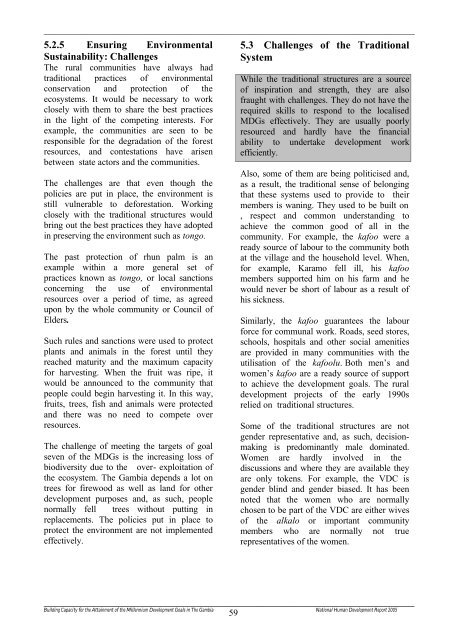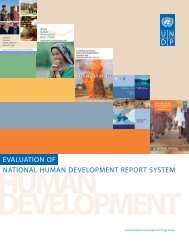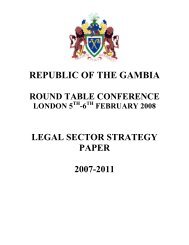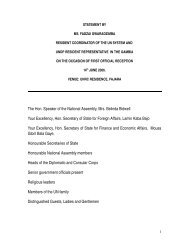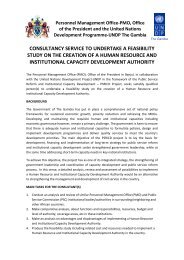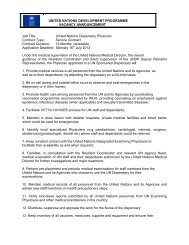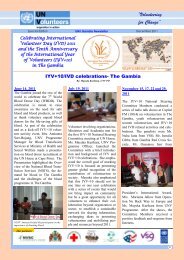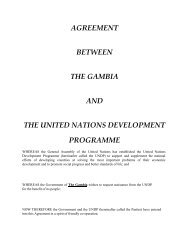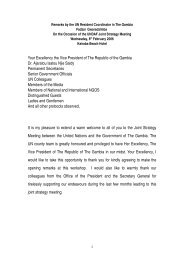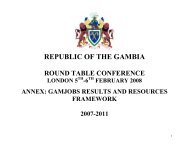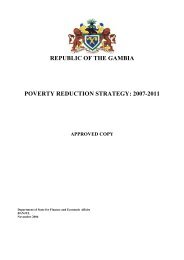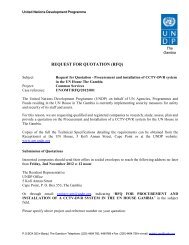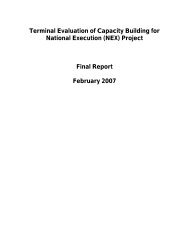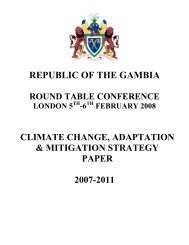Introduction - UNDP The Gambia
Introduction - UNDP The Gambia
Introduction - UNDP The Gambia
You also want an ePaper? Increase the reach of your titles
YUMPU automatically turns print PDFs into web optimized ePapers that Google loves.
________________________________________________________________________________________________________________________<br />
5.2.5 Ensuring Environmental<br />
Sustainability: Challenges<br />
<strong>The</strong> rural communities have always had<br />
traditional practices of environmental<br />
conservation and protection of the<br />
ecosystems. It would be necessary to work<br />
closely with them to share the best practices<br />
in the light of the competing interests. For<br />
example, the communities are seen to be<br />
responsible for the degradation of the forest<br />
resources, and contestations have arisen<br />
between state actors and the communities.<br />
<strong>The</strong> challenges are that even though the<br />
policies are put in place, the environment is<br />
still vulnerable to deforestation. Working<br />
closely with the traditional structures would<br />
bring out the best practices they have adopted<br />
in preserving the environment such as tongo.<br />
<strong>The</strong> past protection of rhun palm is an<br />
example within a more general set of<br />
practices known as tongo, or local sanctions<br />
concerning the use of environmental<br />
resources over a period of time, as agreed<br />
upon by the whole community or Council of<br />
Elders.<br />
Such rules and sanctions were used to protect<br />
plants and animals in the forest until they<br />
reached maturity and the maximum capacity<br />
for harvesting. When the fruit was ripe, it<br />
would be announced to the community that<br />
people could begin harvesting it. In this way,<br />
fruits, trees, fish and animals were protected<br />
and there was no need to compete over<br />
resources.<br />
<strong>The</strong> challenge of meeting the targets of goal<br />
seven of the MDGs is the increasing loss of<br />
biodiversity due to the over- exploitation of<br />
the ecosystem. <strong>The</strong> <strong>Gambia</strong> depends a lot on<br />
trees for firewood as well as land for other<br />
development purposes and, as such, people<br />
normally fell trees without putting in<br />
replacements. <strong>The</strong> policies put in place to<br />
protect the environment are not implemented<br />
effectively.<br />
5.3 Challenges of the Traditional<br />
System<br />
While the traditional structures are a source<br />
of inspiration and strength, they are also<br />
fraught with challenges. <strong>The</strong>y do not have the<br />
required skills to respond to the localised<br />
MDGs effectively. <strong>The</strong>y are usually poorly<br />
resourced and hardly have the financial<br />
ability to undertake development work<br />
efficiently.<br />
Also, some of them are being politicised and,<br />
as a result, the traditional sense of belonging<br />
that these systems used to provide to their<br />
members is waning. <strong>The</strong>y used to be built on<br />
, respect and common understanding to<br />
achieve the common good of all in the<br />
community. For example, the kafoo were a<br />
ready source of labour to the community both<br />
at the village and the household level. When,<br />
for example, Karamo fell ill, his kafoo<br />
members supported him on his farm and he<br />
would never be short of labour as a result of<br />
his sickness.<br />
Similarly, the kafoo guarantees the labour<br />
force for communal work. Roads, seed stores,<br />
schools, hospitals and other social amenities<br />
are provided in many communities with the<br />
utilisation of the kafoolu. Both men’s and<br />
women’s kafoo are a ready source of support<br />
to achieve the development goals. <strong>The</strong> rural<br />
development projects of the early 1990s<br />
relied on traditional structures.<br />
Some of the traditional structures are not<br />
gender representative and, as such, decisionmaking<br />
is predominantly male dominated.<br />
Women are hardly involved in the<br />
discussions and where they are available they<br />
are only tokens. For example, the VDC is<br />
gender blind and gender biased. It has been<br />
noted that the women who are normally<br />
chosen to be part of the VDC are either wives<br />
of the alkalo or important community<br />
members who are normally not true<br />
representatives of the women.<br />
________________________________________________________________________________________________<br />
Building Capacity for the Attainment of the Millennium Development Goals in <strong>The</strong> <strong>Gambia</strong> National Human Development Report 2005<br />
59


